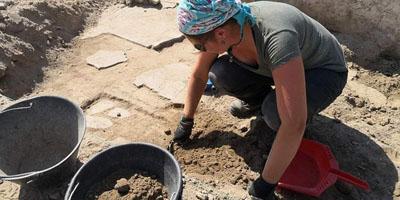2018 season
Excavation and survey work at the site in 2018.

Work this year built on the excavation and survey work completed the year before. Two existing trenches were expanded and two new ones opened.
In Area A, where we identified a theatre in 2017, new work was undertaken to continue the exploration of the substructures of the cavea and a ring drain running around the perimeter of the orchestra. The former provided useful new data on the late antique demolition of the structure, including a fifth-century AD deposit relating to occupation in the ruins of the theatre during its dismantling. Volcanic deposits relating to the AD 472 eruption of Vesuvius were identified over this occupation level.
In the baths, Area B, the trench from 2017 was extended and a new area of the marble paved room to the north of the frigidarium exposed. Further volcanic deposits, in this case combined with roof tiles, indicating a collapse, confirmed that the building was damaged and probably put out of use by this eruption.
The two new areas of excavation were opened on the north edge of the forum and in the area east of the baths, where the GPR in 2016 picked up evidence for a major road. The forum trench found little evidence for the Roman phase of the forum, which had been extensively spoliated. The north edge of the complex was clearly monumentalised in some way, apparently with a semi-circular structure, but all of the walls of this building have been removed. An earlier cut in this area, probably made in the 1960s, however, enabled us to explore levels beneath the Roman forum and here we uncovered a mudbrick wall and platform, associated with which was pottery from the 4th to 2nd centuries BC. Fragments of architectural terracottas and stucco also suggest that late Republican or early Imperial buildings once occupied this area. Beneath this mudbrick structure a series of deposits could be traced down as far as a volcanic event, attested by a thick pumice layer, characteristic of the prehistoric eruption of Vesuvius. This material represents the earliest evidence so far identified for life at Aeclanum. The final trench, located over the apparent roadway, confirmed that this was indeed a major thoroughfare running north-south through the city. The road was paved with basalts and, at a width of at least 5 m, is very likely to represent the ancient Via Appia. Along its western side a shop, probably forming part of a row of buildings, was identified, which had again been spoliated in late antiquity; the remains of a small furnace testifies to the systematic character of this spoliation.
GPR survey continued in 2018 and was concentrated on the ridge projecting west of the forum. Further blocks of residential structures were identified, as well as a complex of large buildings. These are arranged perpendicular to the known church and the largest has an apsidal end; they could represent the remains of a major ecclesiastical complex.

